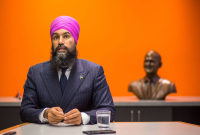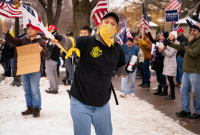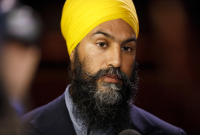Support strong Canadian climate journalism for 2025
With an imminent federal election expected as early as this month, much has been written about the NDP’s revitalized electoral prospects under the leadership of Jagmeet Singh.
Since becoming leader in 2017, Singh — the first visible minority to lead a major national party in Canada — has confronted numerous challenges. It took him a gruelling 17 months to enter the House of Commons, and his performance throughout the 2019 election campaign was uneven at best, leading the NDP to win a mere 24 seats on election day — down from 44 seats in the 2015 election.
For much of the pandemic, Singh struggled to attract media coverage as the federal Liberal government rolled out unprecedented spending initiatives to support individuals and help businesses shoulder the economic burdens from the pandemic. But over the spring and summer, the ground has seemingly shifted considerably in favour of Singh’s leadership.
A recent Abacus Data public opinion poll suggests Singh is the most popular national political leader, with robust support among women, younger voters, and British Columbians.
In recent weeks, Singh’s leadership momentum has had a halo effect on his party’s standing in the polls. Several respected polling firms now show the NDP duking it out with the Conservatives for second-place support. These recent trends have even led some prominent pundits and pollsters to speculate on whether Singh’s party could win more votes (not seats) than Erin O’Toole’s floundering Conservatives in an anticipated fall election.
The notion that Singh’s NDP could possibly compete for second place would have been unfathomable six months ago. Less explored among the pundits, has been an explanation of the increasing support for Singh and his party.
The global COVID-19 pandemic and its calamitous public health and economic impacts have played to the NDP’s historic strengths as a party that has long advocated for robust government intervention in the Canadian economy as a means to support the most vulnerable.
COVID-19 has shone a light on the structural inequalities in Canadian society, with blue-collar and precarious workers having borne the economic brunt of the pandemic, while white-collar workers have remained relatively unscathed, and in some cases, have profited.
The NDP has been pointing to these fundamental economic inequalities for decades with limited success, but the unparalleled events of the past 18 months have underscored the NDP’s long-held value proposition among left-leaning voters. While it’s difficult to know how much influence the NDP leader has realistically wielded in Ottawa throughout this crisis, Singh can credibly tell voters that it was him and his MPs who pushed the Trudeau government to increase the value and duration of the several financial support programs that have sustained nearly nine million Canadians throughout the pandemic.
If the pandemic has had any net impact on Canadians’ political leanings, after more than a generation, it has reintroduced the merits of interventionist governments and the life-saving impacts they can have on people’s lives in times of crisis and economic disparity.
This gradual shift in public opinion away from the orthodoxies of austerity — and how Singh has shrewdly taken advantage of it — has given the NDP a new lease on life. Singh will no doubt capitalize on this public goodwill and argue the Liberals don’t deserve a majority government, imploring voters to “send more New Democrats to Ottawa” as a means to hold Justin Trudeau accountable.
The second global development that has lifted Singh’s electoral prospects has been the relatively new public discourse around a racial reckoning and the need to stamp out systemic racism in the United States and Canada.
In May 2020, George Floyd, a Black man, was killed by a white police officer in Minneapolis. Floyd’s murder triggered an outpouring of anger, protest, and public support from racialized and non-racialized communities in the U.S. and in major Canadian cities such as Toronto and Vancouver — traditional bastions of NDP support.
Singh reacted swiftly to the reinvigorated Black Lives Matter movement with fervour, challenging Trudeau to use his position of power to “go beyond pretty words, and pretty speeches, and do something.” He also urged the Liberal government to commit to ending racial profiling and address the over-incarceration of Black people in Canada.
Days later, Singh championed a motion in the Commons recognizing the existence of systemic racism in the RCMP after several Indigenous people had died at the hands of its officers in early 2020.
Singh’s leadership on calling out the systemic racism experienced by Indigenous Canadians proved prophetic when less than a year later, the gravesites of hundreds of Indigenous children were identified near the former sites of five Canadian Indian residential schools in Western Canada. As these horrific discoveries continued this summer, Singh once again rose to the occasion becoming a powerful ally and champion for Indigenous communities.
Standing alongside Nunavut NDP MP Mumilaaq Qaqqaq, he used his platform to repeatedly stress that only 13 of the Truth and Reconciliation Commission of Canada’s 94 Calls to Action have been implemented by the Trudeau government since its report was released in 2015.
Finally, just as Canadians were beginning to digest the horrors surrounding this country’s legacy of Indian residential schools, an innocent, multi-generational Muslim family was killed in London, Ont., in a terror attack motivated by Islamophobia and racism. As Muslims and other religious minorities across Canada reacted with profound sadness and fear, Singh was warmly received when he rose to address the London Muslim Mosque’s memorial in honour of the family, which was broadcast across the nation.
As a visibly emotional Singh spoke to the crowd, it was immediately apparent he had forged an authentic connection with the Muslim community in a way Trudeau and O’Toole could not, as the first non-white, turban-wearing national political leader in Canada. Singh’s rare ability to capture a moment of great sorrow and use it to speak to the aspirations and fears of racialized Canadians and religious minorities was unmistakable. With almost a quarter of Canadians identifying as visible minorities, this is a potent demographic for Singh to tap into.
With the left-leaning Green Party in complete disarray and a severely weakened Conservative Party of Canada, it is Singh, not O’Toole, who may ultimately prevent Trudeau’s Liberals from forming a majority government. Beyond the significant global and national events of the past two years that have played to the NDP’s strengths and their leader’s unique offering, Singh has arguably become a stronger leader throughout the pandemic.
His public performances have measurably improved since his early days as party leader, and he now appears far more at ease under media scrutiny. And while Singh continues to oppose this government with steely determination, he displays a relentlessly sunny disposition reminiscent of the late Jack Layton and in stark contrast to the often dour O’Toole.
Singh has one last secret weapon at his disposal: Young people. As the only federal party leader active on the popular video-sharing app TikTok, Singh is light years ahead of his rival party leaders when it comes to engaging young Canadians. Singh boasts an impressive 625,000 followers on the social media app, where users typically post short clips featuring popular songs, dances, and trends. His over 80 videos have been “liked” more than five million times, with many going viral. The Toronto Star recently dubbed Singh a “TikTok superstar,” noting the leader has leveraged the app to reach younger audiences and discuss key NDP policies on climate change, paid sick leave, systemic racism, and Indigenous reconciliation.
As Canadians ponder their electoral options over the coming weeks, Singh could be the federal party leader with the most to gain on the campaign hustings. If he is able to translate the palpable enthusiasm for his leadership — among blue-collar workers, racialized, and young Canadians — into votes at the ballot box, then Singh will be poised to make historic gains for the NDP come election day.
Andrew Perez is a Toronto-based public affairs professional whose work includes government relations. Over the past decade, he has worked in a variety of public- and private-sector environments advising senior leaders on communication strategies in their interactions with governments and the media. Perez has volunteered on several political campaigns over the years for the federal and Ontario Liberal parties and remains politically active.
You can follow him on Twitter @andrewaperez.






Comments
Check the links in your newsletter. If you click on Singh you get DND
One scant reference to climate. Though I see a link to another Observer op-ed from April — before the recent deadly heatwave in the West: "Jagmeet Singh needs to get serious about climate change".
From this vantage point, Singh has been just about silent on climate and the need to transform Alberta's energy sector.
We need bold leadership on the issue of our time. None of the mainstream parties is willing to step up to the plate. As noted, the Green Party of Canada has imploded over Israel/Palestine.
This voter is not optimistic that an imminent federal election will change the discussion on climate, much less shift policy.
Meanwhile, Rome continues to burn.
Like I said if the NDP is the bench mark for being progressive in Canada it's a pretty low bar.Every issue raised in this analysis is just that "an issue." Can't go wrong with anti-racism; you don't have to be "progressive" to be anti-racist. Government support when Canadians on are the down, like with COVID, once again, a no-brainer and you can even be a Liberal.
What the NDP lacks is a back bone They have no guts and no courage to be truly progressive. They need a serious backbone on climate change - as his provincial counter-parts (those in power in BC and those not in power in Alberta) continue to subsidize oil and gas industries, massive logging, destructive mining, etc.
What the NDP lacks is a vision for Canada. A comprehensive and meaningful PLAN to bring Canada into the 21st century. For example, tweaking around the edges on the blame and shame social safety when it needs a seriously new vision and complete overhaul based on compassion and dignity for all Canadians, the NDP maintains the status quo and even makes it worse (the NDP cutbacks in the 1990s in BC is one good example, or the one-time $300 boost for poor seniors during the pandemic - a one-time only?).
A truly progressive party would have a global plan to make Canadian society a more equitable, compassionate and modern society. Instead we get "issues" that are pretty hard to argue with no matter what party you are aligned with. Oh and by the way, the NDP does not support Proportional Representation as was amply demonstrated by John Horgan and his government in BC when they had a chance to script a referendum question to encourage PR, instead they scripted a question doomed to fail. Also, when they were in a position to share power and it was working well, Horgan couldn't wait to call a snap election during the pandemic to secure total power because he was "tired" of having to work with another party. John, this is what PR looks like.
So, give me a break. Progressives in this country need to wake up and demand far more than the 20th-century thinking of the NDP.
Two good things can come about with the second place finish for the NDP. 1) it will force the Conservatives to rebuild the fractured party they now live with. 2) it will bring about the power of the young voters that want the best for the country on climate and economic issues, and not just a narrow field of interests out west.
Putting a stop to foreign Real Estate speculation witch is hurting young families across this country is going to be a big part of the possible November 2021 election.